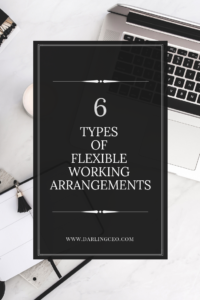if you work in a corporate environment, you have undoubtedly heard the term flexible working arrangement. A flexible working arrangement (FWA) is simply an alternative working location and/or schedule. Employees love them because it allows them more flexibility to balance work and home. Whether you are a business owner considering offering a flexible working arrangement or an employee interested in requesting one, it is important to understand what is available. Here are the 6 most common types of flexible working arrangements.
Telecommuting
More companies are offering employees the option to work remotely at least part of the time. It makes total sense too. Studies show that working from home helps increase productivity, improves employee engagement, and helps employers lower overhead costs. Sounds like a win-win! Many employers/employees wonder how often you should be in the office. While there is no one size fits all answer, studies by Gallup have shown that the telecommuting schedule that offers the most productivity is when an employee comes into the office two or three days per week.
Working Remotely
Similar to telecommuting, working remotely means that an employee works exclusively from another location other than the office. This is becoming an increasingly popular option as technology permits work to happen anywhere. An employee needs to make sure that they have a suitable space free from distractions. It is also important to have very clear expectations as it relates to performance. It takes a lot of trust from an employer to offer this arrangement so you will want there to be clear accountability on each side.
Compressed Work Week
A compressed work week is just as the name suggests, compressing a 40-hour workweek into three to four days. Most commonly, a compressed workweek consists of four 10-hour days. This is not only great for the employee, but it can also help an employer keep overhead costs down. This is a great option for working parents to help them keep childcare costs down.
Flexible Working Schedule
This arrangement allows the employee to select their working hours when it works best for them. For example, a working mother can work a couple hours in the morning, four hours during the school day, and finish up her work after the kids go to bed. This also improves productivity because it allows workers the chance to select times in which they are naturally more productive.
Part Time or Reduced Schedule
Some employees prefer working a part-time schedule versus a full 40+ hour workweek. Let’s be honest, working full time does not always guarantee a full 40 hours of productivity. A ton of time is lost on “water-cooler chats” and employees shopping on Amazon during work time. Employers are finding out that they can get comparable productivity from part-time employees. This option is not for everyone though. I have had several friends that went part-time and ended up hating it. They felt that they were never giving their full self to anything. If you are an employee considering this option, try to chat with people in similar roles that have gone part-time to see how they like it and what advice they would give.
Flexible Time Off
Unlimited vacation time is an increasingly popular flexible working arrangement. Offering an employee the option to take time off when they need without the restraint of a fixed allotment helps them manage their work and home life more effectively. It also results in less unscheduled absences where you may be scrambling to fill in for that person.
Do you participate in a flexible working arrangement? If so, what does it look like? What are the pros and cons? We would love to hear, leave a comment below!
Pin Me

Leave a Reply